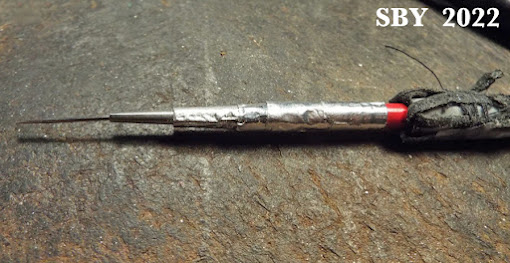In the past week much progress was made on updating this 2003 saddle. All 18 drops were made and installed. New saddle conchos were invented and put on, something which involved taking the seat off! The silver of the pommel was fixed up with a new underlayer. At this point only two steps remain, the tapadero conchos and the cinch. I am pretty pleased with #430 at this point.
Eighteen new drops were hung, 10 on the breastcollar and 8 on the serapes. I finally got into the groove of making the drops. It involved a white-glue phase where the Mylar tinsel was inserted into slits and held down; then the pins, strung with silver balls, had to pierce the middles (they are folded over). Then the two halves of each drop had to be glued together. Then I trimmed off 4 corners per drop. I had bought new scissors and I really liked how easily they could do that trimming! Chop, chop! I liked the almost-jet-jewelry look of the new drops; they remind me of great beads. Yet it's just Mylar and leather.
The seat really did come off. I'd pulled off the lining and cut all the pins that held it on. I decided I didn't like the green corrosion on those pins and sought for a way to replicate the job they'd done -- hold the seat on and the saddle together -- without using pins. This was a strikingly major design change from all my past. Yet it was solved within a day. Just sew the little things together. Place an ikandi (iron-on) concho where the conchos should be, and roll on. And so it happened.
I did, however, need to place a pin at the 2nd concho point, the one below the pommel welt. I used a stiff steel pin for them, hoping it would corrode less than the soft brass ones. As evidence I point to the same stiff pins used for the tapadero necks. They don't seem to have gone green in their 19 years. I really like working with these tack pieces after 10, 20, 30 years because I can see what corroded and what didn't -- it is fascinating. Aluminum works; brass does not. Dang I wish I had Aluminum pins -- that would solve everything!
The tapadero conchos remain to be dealt with, more Rio Rondo conchos which I am no longer happy with. The picture doesn't show it, but they gained a coating of yellow-greenish exudate as well. I've scratched it off here, but their silver-color and texture does not match the rest of the saddle. I have a few options here, but I'm afraid the pins (necks) will have to come out and be replaced. And I ran out of time tonight.
On the good news side, the new cinch for TSII #430 should be fun. I've printed out my Willow Northland cinch tutorials and will be taking them along on the next birding vacation (May 28-June 5). This is just the right project for evenings.

























